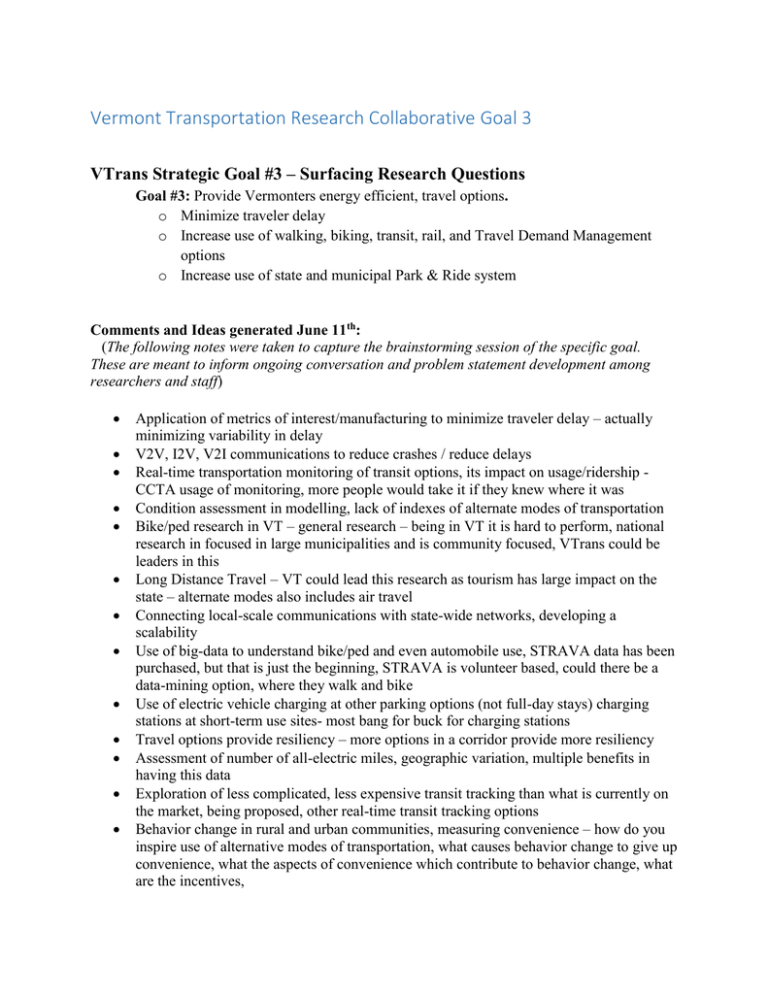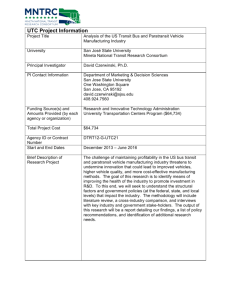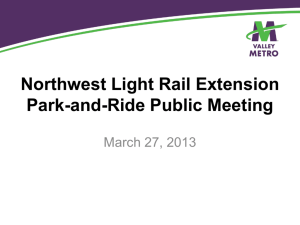Vermont Transportation Research Collaborative Goal 3
advertisement

Vermont Transportation Research Collaborative Goal 3 VTrans Strategic Goal #3 – Surfacing Research Questions Goal #3: Provide Vermonters energy efficient, travel options. o Minimize traveler delay o Increase use of walking, biking, transit, rail, and Travel Demand Management options o Increase use of state and municipal Park & Ride system Comments and Ideas generated June 11th: (The following notes were taken to capture the brainstorming session of the specific goal. These are meant to inform ongoing conversation and problem statement development among researchers and staff) Application of metrics of interest/manufacturing to minimize traveler delay – actually minimizing variability in delay V2V, I2V, V2I communications to reduce crashes / reduce delays Real-time transportation monitoring of transit options, its impact on usage/ridership CCTA usage of monitoring, more people would take it if they knew where it was Condition assessment in modelling, lack of indexes of alternate modes of transportation Bike/ped research in VT – general research – being in VT it is hard to perform, national research in focused in large municipalities and is community focused, VTrans could be leaders in this Long Distance Travel – VT could lead this research as tourism has large impact on the state – alternate modes also includes air travel Connecting local-scale communications with state-wide networks, developing a scalability Use of big-data to understand bike/ped and even automobile use, STRAVA data has been purchased, but that is just the beginning, STRAVA is volunteer based, could there be a data-mining option, where they walk and bike Use of electric vehicle charging at other parking options (not full-day stays) charging stations at short-term use sites- most bang for buck for charging stations Travel options provide resiliency – more options in a corridor provide more resiliency Assessment of number of all-electric miles, geographic variation, multiple benefits in having this data Exploration of less complicated, less expensive transit tracking than what is currently on the market, being proposed, other real-time transit tracking options Behavior change in rural and urban communities, measuring convenience – how do you inspire use of alternative modes of transportation, what causes behavior change to give up convenience, what the aspects of convenience which contribute to behavior change, what are the incentives, Private parking spaces and leasing options for electric vehicle charging stations, for malls and grocery chains Behavioral economics and data-mining options Where is behavior change possible – are there communities where it is impossible, could a spatial map be developed to identify which communities will change their behavior Could current OBD devices be used to back-into all electric miles for hybrid vehicles (inventory of UVM technology and capability, stimulate research for outside sources) Leverage existing data to look at congestion and levels of service and then target service based on that information, understanding tap data sources Replacement of gas-tax in the long-term, how take advantage of technology to provide alternate funding, vehicle miles and travel tax Contribution of climate which deters behavior Motivation of electric vehicle adoption in rural communities, urban areas – HOV, what variables are there for rural areas, what’s the break-even point on developing infrastructure - commuter rail and is it feasible Rural UBER option, what would the impact be on congestion, what type of mobility services are there for VT, what is that system is a private-market system or is it statesupported (fewer vehicles on the road, need cellular service for that to work, perceived convenience) Partnering with private-sector in transit options, identifying how behavioral change impacts ridership, analyzing data from employers on commuting behavior to identify possible route options Exploration of UAS in their use of assessing highway and bridge infrastructure, tree health, search-and-rescue options, exploration of FAA certification for the agency to use them in operations (utilizing UAS to increase safety, efficiency instead of using big trucks to that) Convenience of park-and-rides, shelter capacity and the use of solar-paneled shelters at park-and-rides, car ports to keep snow off the vehicles, could it expand the number of charging options Electric vehicle charging network and the park-and-ride system Latent park-and-ride demand - expand the park-and-ride, piggy back or interview the private sector large employers to see what their commuters go through Bus shelters at park-and-rides and bus ridership (insufficient infrastructure at current shelters) – weather and user ship, shelter needs to hold more people Park-and-ride off the interstate system, other state highways, there are de-facto options, but could formalized park-and-ride options be looked at



